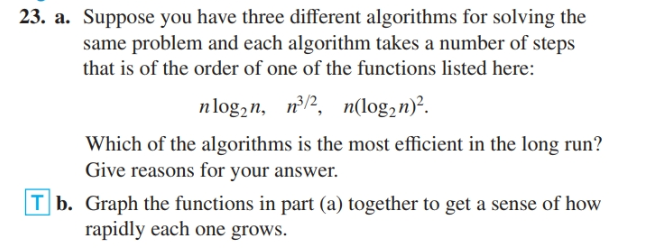23. a. Suppose you have three different algorithms for solving the same problem and each algorithm takes a number of steps that is of the order of one of the functions listed here: nlog,n, n/2, n(log,n)². Which of the algorithms is the most efficient in the long run? Give reasons for your answer. T b. Graph the functions in part (a) together to get a sense of how rapidly each one grows.
23. a. Suppose you have three different algorithms for solving the same problem and each algorithm takes a number of steps that is of the order of one of the functions listed here: nlog,n, n/2, n(log,n)². Which of the algorithms is the most efficient in the long run? Give reasons for your answer. T b. Graph the functions in part (a) together to get a sense of how rapidly each one grows.
Algebra & Trigonometry with Analytic Geometry
13th Edition
ISBN:9781133382119
Author:Swokowski
Publisher:Swokowski
Chapter5: Inverse, Exponential, And Logarithmic Functions
Section5.6: Exponential And Logarithmic Equations
Problem 64E
Related questions
Question
100%

Transcribed Image Text:23. a. Suppose you have three different algorithms for solving the
same problem and each algorithm takes a number of steps
that is of the order of one of the functions listed here:
nlog,n, n/2, n(log,n)².
Which of the algorithms is the most efficient in the long run?
Give reasons for your answer.
T b. Graph the functions in part (a) together to get a sense of how
rapidly each one grows.
Expert Solution
This question has been solved!
Explore an expertly crafted, step-by-step solution for a thorough understanding of key concepts.
This is a popular solution!
Trending now
This is a popular solution!
Step by step
Solved in 2 steps with 2 images

Recommended textbooks for you

Algebra & Trigonometry with Analytic Geometry
Algebra
ISBN:
9781133382119
Author:
Swokowski
Publisher:
Cengage

Linear Algebra: A Modern Introduction
Algebra
ISBN:
9781285463247
Author:
David Poole
Publisher:
Cengage Learning

Algebra & Trigonometry with Analytic Geometry
Algebra
ISBN:
9781133382119
Author:
Swokowski
Publisher:
Cengage

Linear Algebra: A Modern Introduction
Algebra
ISBN:
9781285463247
Author:
David Poole
Publisher:
Cengage Learning